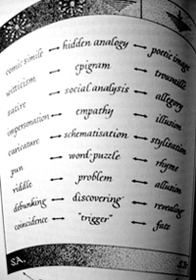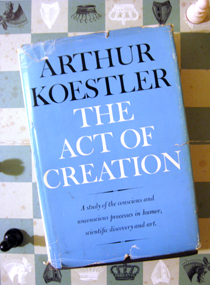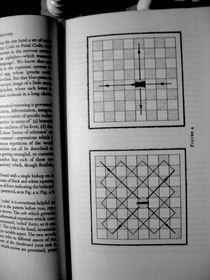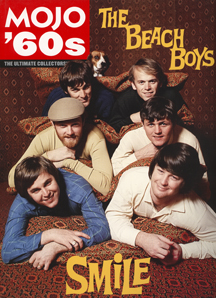This article was written for Endless Summer Quarterly magazine and was published in their special SMiLE issue (thank you David Beard!) from December 2011.
The ESQ article is presented in blue type. Quotes from The Act Of Creation are presented in italics and are hopefully discernible via the context.
SMiLE and The Act Of Creation
Brian Wilson's biography told of a bookstore experience interpreted as something "comparable to Zen riddles, mysteries full of meaning," and a favorite record of Brian's, How To Speak Hip, mentions that the "the Zen Buddhists have these koans, you know, they're riddles that you meditate on...". The biography also has Brian asking his astrologer about the direction of his next album project (Pet Sounds) by using the riddle form.
For many years, I had mistakenly assumed that SMiLE was organically based upon personal experience. The idea was that Brian contemplated the riddle--had the ultimate religious experience---envisioned the riddle/album & soon thereafter went to work on SMiLE. My theories went so far as to choose Lake Arrowhead as the locale for spiritual event. But I was wrong. There was still an ingredient missing in the equation. To make an album with the potential to prompt a religious experience a favorite book of Brian's was used, Arthur Koestler's The Act Of Creation: A study of the conscious and unconscious process in humor, scientific discovery and art. The triptych at the books' frontispiece shows logical patterns of creative activity across the humor, discovery, and art spectrums. One listed pattern begins with the riddle and ends with art's allusion.
riddle <----> problem <----> allusion
Mr. Koestler maintains that the logic behind the truly creative act in any and all these areas is basically the same and he uses humor to illustrate the point.
Humour is the only domain of creative activity where a stimulus on a high level of complexity produces a massive and sharply defined response on the level of physiological reflexes.
The physiological reflex produced is explained by referencing Sully's An Essay On Laughter.
Smiling involves a complex group of facial movements...
These facial changes are common to the smile and the laugh...
As Darwin and others have pointed out, there is a series of gradations from the faintest and most decorous smile up to the full explosion of the laugh.
We see in classical languages a tendency to employ the same word for the two...This is particularly clear in the case of the Latin ridere, which means to smile as well as to laugh...
Koestler then uses humorous stories to illustrate and explain the logic behind laughter.
The pattern underlying both stories is the perceiving of a situation or idea, L, in two self-consistent but habitually incompatible frames of reference, M1 and M2. The event L, in which the two intersect, is made to vibrate simultaneously on two different wavelengths, as it were. While this situation lasts, L is not merely linked to one associative context, but bisociated with two.
I have coined the term 'bisociation' in order to make a distinction between the routine skills of thinking on a single 'plane', as it were, and the creative act, which, as I shall try to show, always operates on more than one plane.
The author later refines the idea of 'plane' by using the term "'matrix' to denote any ability, habit, or skill, any pattern of ordered behavior by a 'code' of fixed rules". A chessboard is used to demonstrate the concept of matrices. Each type of chess piece has a unique code of permissible movements while the board represents all the possible choices for that piece. The bishop's movement matrix is different from the matrix for the rook (one can find the chessboard in Frank Holmes' SMiLE artwork, Van Dyke Parks' "Surf's Up" lyric, and the check pattern on the Beach Boys' Western shirts).
Mr. Koestler uses the example of riding a bicycle to illustrate that the majority of our behavior and thinking is done on an unconscious level. What the author is essentially getting at is the paradigm of one matrix operating on the conscious level of the mind and another matrix on the unconscious level, and their bisociation, as a model for original creative thought.
When two independent matrices of perception or reasoning interact with each other the result...is either a collision ending in laughter, or their fusion in a new intellectual synthesis, or their confrontation in an aesthetic experience. The bisociative patterns found in any domain of creative activity are tri-valent: that is to say, the same pair of matrices can produce comic, tragic, or intellectually challenging effects.
At this point I must apologize if I've confused the heck out of anyone. I know I'm confused, but the take away from the above is that SMiLE operates on two levels or matrices. One is on the conscious level while the other is on the unconscious level.
"He wanted to make the American saga a legitimate currency in this new global music market that had just defined itself since 1964. It was his game."
- Van Dyke Parks
On the conscious level we have the Americana matrix. Sometimes justifying this matrix has been problematic for logicians as the hints of the unconscious matrix don't logically fit the assumed code.
...thinking which remains confined to a single matrix has its obvious limitations. It is the exercise of a more or less flexible skill, which can perform tasks only of a kind already encountered in past experience; it is not capable of original, creative achievement.
"I supported the integrity of his lyricism in melody;
I was there to support his 'dream-escape.'"
- Van Dyke Parks
There are two ways of escaping our more or less automated routines of thinking and behaving. The first, of course, is the plunge into dreaming or dream-like states, when the codes of rational thinking are suspended. The other way is also an escape---from boredom, stagnation, intellectual predicaments, and emotional frustration---but an escape in the opposite direction: it is signaled by the spontaneous flash of insight which shows a familiar situation or event in a new light, and elicits a new response to it. The bisociative act connects previously unconnected matrices of experience; it makes us 'understand what it is to be awake, to be living on several planes at once'...
SMiLE's "Fire" music provides a simple illustration of the two matrices. The music represents the unconscious level (Brian's bio connects the fire to an LSD trip) while the piece's title, "Mrs. O'Leary's Cow", has a definite American connotation.
We can also play this game on a larger scale. Take the "Barnyard" lyrics etched into the 78 rpm release from April of this year.
Jump in the pig pen,
Next time I'll take my shoes off.
Hit the dirt, do two and a half,
Next time I'll leave my hat off.
These are likely to be considered fine examples of SMiLE's Americana theme. With some imagination though the pig pen could be Brian's SMiLE era's sloppy sandbox. With his shoes off---the dirt may be the sand on the beach presumably where he had the ultimate religious experience and the two and a half could be the amount of LSD trips taken at that point (see Brain's bio for this). These reference the unconscious level of experience.
There are some who will no doubt question the idea of the sandbox as having anything to do with the unconscious. Arthur Koestler explains how such an item might help an artist actually tap into the unconscious.
...though the unconscious processes cannot be governed by conscious volition, they can at least be coaxed into activity by certain tricks acquired at the price of a little patience. Friedrich Schiller learned to get himself into a creative frame of mind by smelling rotten apples, Turgenev by keeping his feet in a bucket of hot water...
Other tools and methods used on SMiLE, such as repetition, are designed to bring the unconscious into play.
...we find all the bisociative patterns that I have discussed prominently displayed in the dream: the pun: two strings of thought tied together by a purely acoustic knot; the optical pun: one visual form bisociated with two functional contexts....the unearthing of hidden analogies: impersonation and double identity---being oneself and something else at the same time, where the 'something else' might belong to the animal, vegetable, or mineral kingdom....
The basic pattern of the bisociation of two matrices can produce a variety of results across the spectrum of emotion. SMiLE's visual and audio content create a mystery the consumer must work out.
Whether he listens to a joke, or reads a scientific work, or visits an art gallery, he is supposed to participate in the intellectual and emotional experiences of the 'producer'---to relive or re-create them...The consumer hopes that by being allowed to share the creator's vision he will gain a deeper and broader view of reality.
There is a classic thematic element present in SMiLE that has been missed almost entirely over the years.
One archetype remains to be discussed, which is of special significance for the act of creation. It is variously known as the Night Journey, or Death-and-Rebirth motif....It appears in countless guises; its basic pattern can be roughly described as follows. Under the effect of some overwhelming experience, the hero is made to realize the shallowness of his life, the futility and frivolity of the daily pursuits of man in the trivial routines of existence. This realization may come to him as a sudden shock caused by some catastrophic event, or as the cumulative effect of a slow inner development, or through a trigger action of some apparently banal experience which assumes an unexpected significance. The hero then suffers a crisis which involves the very foundations of his being; he embarks on the Night Journey, is suddenly transferred to the Tragic Plane---from which he emerges purified, enriched by new insight, regenerated on a higher level of integration.
Evidence of this theme in SMiLE can be inferred from Jules Siegel's classic article (the SECONDS account and Brain's "Surf's Up" explanation) or from the lyrics for "On A Holiday."
All of this adds up to a record album that was meant to operate on another level entirely.
Art, like religion, is a school of self-transcendence; it expands individual awareness into cosmic awareness...
And Brian Wilson felt that the humor level could yield something as well.
"He felt that the moment somebody laughed, that while they're laughing,
that all control was gone. They cannot control themselves.
And at that moment they can have a spiritual experience."
-Michael Vosse
Capitol Records' ad for the album included the banner: Look! Listen! VIBRATE! SMILE! and Arthur Koestler's The Act Of Creation illuminates and unfolds the intended process.
This article is meant as a simple introduction to the subject. Perhaps some readers will now be able to detect the two matrices at work in the comments and contributions of the album's three creators. Hopefully someday someone smarter and more impressive than myself will go further into such an analysis. At that point Koestler's and Wilson's 'dada-ness' can be properly revealed.
P.S.- The more unlikely or 'far-fetched' the mediating matrix M2---i.e. the more independent from M1---the more unexpected and impressive the achievement. The creative act could be described as the highest form of learning because of the high improbability (or anti-chance probability) of the solution.
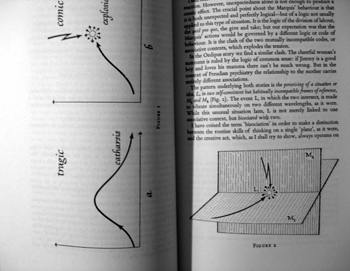
http://www.esquarterly.com/about_esq.html
